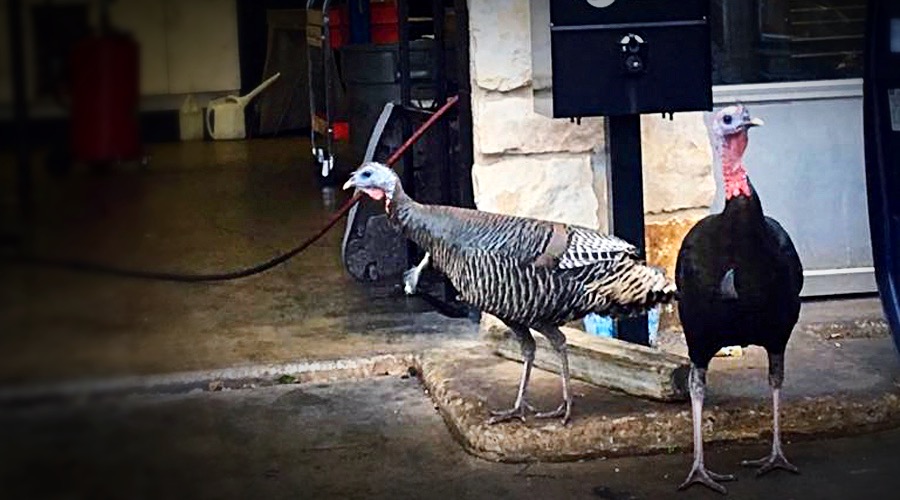Lakeway has literally gone to the birds, friends. No, not because of traffic and commercial development, but because of literal birds. Specifically, two turkeys.
For Lake Travis resident Suzy Aubert, the tale of two turkeys in Lake Travis has been a mystery since May of 2017, when she spotted this fab fowl duo on her property in Serene Hills.
The first time she saw them it was quite a shock because you typically don’t see two turkeys waddling across your lawn in Lakeway. Wild boars, roadrunners, skunks, possum, coyotes — yes — but not turkeys. Now it’s becoming commonplace.
Lakeway isn’t being overrun by a rafter of turkeys, it’s just these two. They supposedly live behind The Lakeway Church and are often spotted across the street at the Lakeway Texaco on the corner of Lakeway Blvd. and Lohmans Crossing (as pictured above).
Why are they here?
Are they a couple? Aww, cute!
When will they leave?
Today we’ll answer all of your burning questions about Lakeway’s Meleagris gallopavo intermedia.
To get the lowdown on these turkeys, I reached out to Lake Travis resident Aaron Webb, an avid outdoorsman. While Aaron doesn’t hunt wild turkey himself, he knows a lot about them.
Texas wild turkeys
According to Aaron, these are Rio Grande wild turkeys, a sub-species that is native to North America. They tend to be found in Texas and surrounding states — think western desert regions like Oklahoma, Kansas, Colorado and New Mexico.
Rio Grande wild turkeys can measure up to four feet tall. Mature males weigh between 16-20 pounds and females (called hens) weigh 8-11 pounds.
Like Bill & Ted
Did these two meet on Tinder for Turkeys? As in, are they a male and female couple? The answer is “no,” they are both young males — also called jakes. Uhm, how can you tell they’re male?
Male wild turkeys have distinguishing features like their beard (a modified feather that hangs from the chest), snood (skin over the beak), dewlap (wattle) and caruncles (skin on the forehead).
Female wild turkeys share some of the same features, but if you know your turkeys like Aaron does, you can tell from a photo if they’re boys or girls. These are boys.
Even though we may not see the hens out and about, they’re nearby.
A couple of youngsters
“You can tell the difference between the mature males and younger males by the tuft of the feather (beard) on their chest,” explains Aaron. Older male turkeys have longer beards. These two turkeys have short beards, so they are juveniles.
Another reason this isn’t a cute turkey couple is that male and female turkeys don’t usually hang out together until mating season. And speaking of mating …
March Madness
Mating season for Rio Grande wild turkeys is in March and that’s when these feathered fellas will gobble.
A mature male’s gobble can be heard for over a mile to let hens know he’s in the area. Likewise, if there are mature males within earshot of the call of the gobble, they will come running to see if there are hens in the area.
Hanging in the habitat
Turkeys spend the day roaming around looking for food. They sleep in trees (called a roost). They will roost in the late evening, stay in the tree all night and then in the early morning they fly down and start roaming in search of food and water.
When will they leave?
“I doubt they will leave,” says Aaron. “Like us, if there’s food, water, and shelter, they will stay.”
Wild turkeys are often found in suburbs like Lakeway and they tend to get quite comfortable. They don’t perceive cars as threats and aren’t easily spooked by humans, so that’s why they nonchalantly cross busy intersections … eek!
Will our plumed pals fly the coop? We shall see. Until then, it’s car washes with a side of turkey at Lakeway Texaco! The folks at Texaco say the turkeys usually show up around 7:30am and again at 5:30pm if you want to see them strut their stuff.

Very interesting! They know a good place to live-Lakeway, T X.
They will stay if they find foodAND WATER. Some are feeding the deer and they will eat there food
I’m sure they end up puttering around the golf course in Lakeway, so name them Ping and Putter.